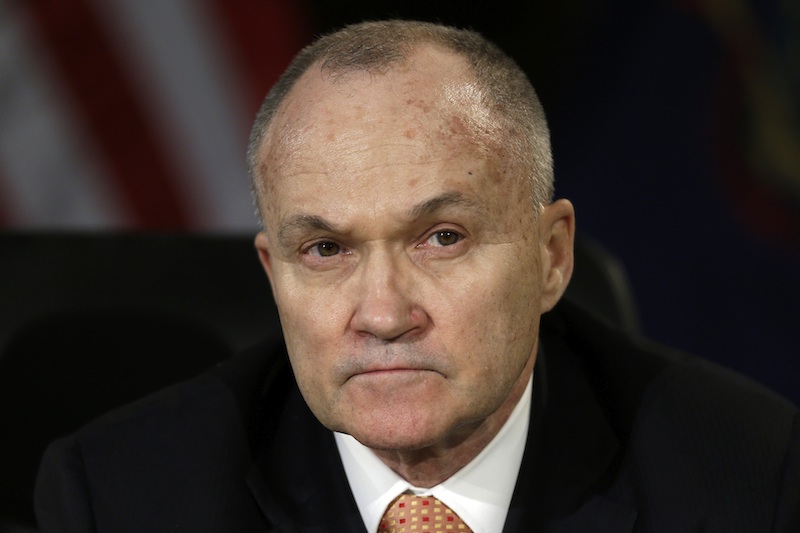When New York City Police Commissioner Raymond Kelly was invited to Brown University to give a speech on Oct. 29, student and community protesters drowned him out, booing and reading tracts explaining why they opposed his policing tactics like the controversial stop-and-frisk policy. With these actions — ebullient, youthful and angry — they were doing exactly what the core principle of free speech suggests they should: combatting Kelly’s speech with their own. In this case, the protesters’ speech happened to be louder, and the Kelly’s talk was interrupted about 30 minutes in. Many, including the university administration, immediately decried the activists as uncouth and even deserving of punishment.
The controversy came to a head last week, with even some prominent liberals calling the protests out of line. But these students engineered the correct response to Kelly, who as NYPD commissioner has been responsible for some of the most odious policing policies this country has seen. Kelly is the architect of stop and frisk, which has been exposed as both broadly racist and individually humiliating. He oversaw an invasive program of spying on Muslim citizens based purely on their religious affiliation. He worked with the creators of a deeply offensive anti-Islam video that was shown to NYPD recruits.
On top of all this, Kelly’s NYPD was responsible for the brutal crackdown on Occupy and a pattern of harsh suppression of other groups in New York who wished to exercise their own First Amendment rights. He has built his career on quashing civil rights, including the right to free expression. And yet despite these seeming disqualifications, Kelly was offered a prominent platform by the academy, not for the first (or presumably last) time.
Kelly was invited to speak by Brown professor Marion Orr (he later apologized for bringing “hurt” to black and Latino students on campus), and that invitation demonstrates that the boundaries of public discourse already exclude many voices.
Let’s do a thought experiment: imagine if Kelly commanded a police force known for strip-searches of young white women. Imagine if said police force had spied routinely on city synagogues, with no cause. Imagine if this police force under Kelly’s command had entered a public park full of concertgoers listening to the Philharmonic and dispersed the crowd violently. All of these hypotheticals seem absurd; had Kelly done any of these things, he would be jobless and an outcast.
Yet the only real distinction between the hypothetical and reality is that Kelly used these outrageous tactics against the city’s underclass, its voiceless and its marginalized. What’s more, elite universities like Brown signal that his perspective is one worth listening to.
By protesting Kelly so vociferously, activists temporarily balanced the scales, repositioning their target from respected public figure to unwelcome pariah. Instead of their voices being continually silenced, his institutional bigotry was cast out of the perimeter of acceptable discussion. In a nice bit of poetry, they exposed him to the same kind of jeering scrutiny young black and brown men receive daily from his officers. They inserted their own voices -Â young, people of color, dissidents – into a conversation that has failed to include them even as its real-world effects fall on their backs. As one brave student, Doreen St. Felix, wrote: “Protest is discourse on the terms of the oppressed, and it takes a ‘disruption’ for marginalized communities to have their voices heard.”
I have participated in and reported on years of protests, from my college campus to the streets of New York, ranging from the silent to whimsical to the aggressive. Different kinds of protest operate to achieve different goals. But I’ve frequently found, even among liberals, a marked aversion to direct actions that disrupt so-called civilized life – blocking the entrance to Wall Street, for example, occupying an administrative building or interrupting a CIA recruitment session.
This baffles me. Disruption is the aim of direct action, as famously articulated by Martin Luther King, Jr. in 1963’s Letter from Birmingham Jail: “Nonviolent direct action seeks to create such a crisis and foster such a tension that a community which has constantly refused to negotiate is forced to confront the issue. It seeks so to dramatize the issue that it can no longer be ignored.”
Direct action is a way of bringing the experience of injustice — the inability to just go on as if life is “normal” — to the doorsteps of the privileged. As a friend of mine said years ago, during a feminist walkout in high school that cut into our classmates’ SAT studying time: “Discomfort for one, discomfort for all.”
I admit that I am struck by the aesthetics of the Kelly protest. I wonder why it’s somehow unworthy of widespread censure when America’s college students gather in loud, jeering and often drunk groups to initiate fraternity members or tailgate at sporting events. These are apparently regarded as semi-healthy expressions of youth – but when tomorrow’s leaders channel their considerable energy to confront an insidious structural problem like NYPD racism, they are pooh-poohed.
It’s a shame. Protest, including direct action, should be a valued part of campus life. It’s good training for a future of speaking truth to power, which would benefit society far more than, say, a degree in economics.
Seltzer is a writer based in New York City. Her work has appeared in Ms. Magazine, The Washington Post, The Nation, and the Forward, among other places. Find her at www.sarahmseltzer.com and tweeting too much at @sarahmseltzer.






